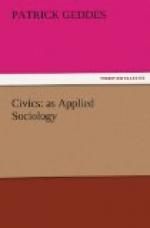Upon the new page, then, it is but a complexer “Town” and “School” anew: we have no continuing City. This too commonly has existed at its best but for the rare generation which created it, or little longer; though its historic glories, like those of sunset and of after-glow, may long shed radiance and glamour upon its town, and linger in the world’s memory long after not only these have faded, but their very folk have vanished, their walls fallen, nay their very site been buried or forgotten. Upon all these degrees of dying, all these faint and fading steps between immortality and oblivion, we may arrange what we call our historic cities. Obviously in the [Page: 95] deeper and more living sense the city exists only in actualising itself; and thus to us it is that the ideal city lies ever in the future. Yet it is the very essence of this whole argument that an ideal city is latent in every town. Where shall we in these days find our cloistered retreats to think out such ideals as may be applicable in our time and circumstances: the needed kinetic ethics, the needed synthetic philosophy and science, the needed vision and imagery and expression of them all?
N—THE EVILS OF THE CITY
Disease, defect, vice and crime
I have spoken little of town evils, and much of town ideals, primarily for the reason that even to recognise, much less treat, the abnormal, we must know something of the normal course of evolution. Hence, the old and useful phrase by which physiology used to be known, that of “the institutes of medicine.” Sociology has thus to become “the institutes of citizenship.”




